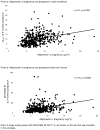Low adiponectin concentration during pregnancy predicts postpartum insulin resistance, beta cell dysfunction and fasting glycaemia
- PMID: 19937225
- PMCID: PMC2878328
- DOI: 10.1007/s00125-009-1600-8
Low adiponectin concentration during pregnancy predicts postpartum insulin resistance, beta cell dysfunction and fasting glycaemia
Abstract
Aims/hypothesis: The postpartum phase following gestational diabetes (GDM) is characterised by subtle metabolic defects, including the beta cell dysfunction that is believed to mediate the increased future risk of type 2 diabetes in this patient population. Low circulating levels of adiponectin and increased leptin and C-reactive protein (CRP) have recently emerged as novel diabetic risk factors, although their relevance to GDM and subsequent diabetes has not been characterised. Thus, we sought to determine whether adiponectin, leptin and CRP levels during pregnancy relate to the postpartum metabolic defects linking GDM with type 2 diabetes.
Methods: Metabolic characterisation, including oral glucose tolerance testing, was undertaken in 487 women during pregnancy and at 3 months postpartum. Based on the antepartum OGTT, there were 137 women with GDM, 91 with gestational impaired glucose tolerance and 259 with normal glucose tolerance.
Results: Adiponectin levels were lowest (p < 0.0001) and CRP levels highest (p = 0.0008) in women with GDM. Leptin did not differ between the glucose tolerance groups (p = 0.4483). Adiponectin (r = 0.41, p < 0.0001), leptin (r = -0.36, p < 0.0001) and CRP (r = -0.30, p < 0.0001) during pregnancy were all associated with postpartum insulin sensitivity (determined using the insulin sensitivity index of Matsuda and DeFronzo [IS(OGTT)]). Intriguingly, adiponectin levels were also related to postpartum beta cell function (insulinogenic index/HOMA of insulin resistance; r = 0.16, p = 0.0009). Indeed, on multiple linear regression analyses, adiponectin levels during pregnancy independently predicted both postpartum insulin sensitivity (t = 3.97, p < 0.0001) and beta cell function (t = 2.37, p = 0.0181), even after adjustment for GDM. Furthermore, adiponectin emerged as a significant negative independent determinant of postpartum fasting glucose (t = -3.01, p = 0.0027).
Conclusions/interpretation: Hypoadiponectinaemia during pregnancy predicts postpartum insulin resistance, beta cell dysfunction and fasting glycaemia, and hence may be relevant to the pathophysiology relating GDM with type 2 diabetes.
Figures


Similar articles
-
[Correlation between the inflammatory factors and adipocytokines with gestational diabetes mellitus and their change in puerperium].Zhonghua Fu Chan Ke Za Zhi. 2012 Jun;47(6):436-9. Zhonghua Fu Chan Ke Za Zhi. 2012. PMID: 22932110 Chinese.
-
Isolated hyperglycemia at 1 hour on oral glucose tolerance test in pregnancy resembles gestational diabetes mellitus in predicting postpartum metabolic dysfunction.Diabetes Care. 2008 Jul;31(7):1275-81. doi: 10.2337/dc08-0126. Epub 2008 Mar 20. Diabetes Care. 2008. PMID: 18356402 Free PMC article.
-
Do adiponectin, TNFalpha, leptin and CRP relate to insulin resistance in pregnancy? Studies in women with and without gestational diabetes, during and after pregnancy.Diabetes Metab Res Rev. 2006 Mar-Apr;22(2):131-8. doi: 10.1002/dmrr.591. Diabetes Metab Res Rev. 2006. PMID: 16170833
-
Characteristics and pregnancy outcomes of subtypes of gestational diabetes mellitus based on HOMA-IR and BMI.Arch Gynecol Obstet. 2024 Nov;310(5):2355-2361. doi: 10.1007/s00404-024-07733-6. Epub 2024 Sep 17. Arch Gynecol Obstet. 2024. PMID: 39287682 Review.
-
Adiponectin and leptin in human severe insulin resistance - diagnostic utility and biological insights.Biochimie. 2012 Oct;94(10):2172-9. doi: 10.1016/j.biochi.2012.01.021. Epub 2012 Feb 4. Biochimie. 2012. PMID: 22342226 Review.
Cited by
-
Alterations of adiponectin gene expression and DNA methylation in adipose tissues and blood cells are associated with gestational diabetes and neonatal outcome.Clin Epigenetics. 2018 Oct 24;10(1):131. doi: 10.1186/s13148-018-0567-z. Clin Epigenetics. 2018. PMID: 30355290 Free PMC article.
-
Analysis of phosphatidylinositol 3-kinase activation in the adipose tissue of gestational diabetes mellitus patients and insulin resistance.J Huazhong Univ Sci Technolog Med Sci. 2010 Aug;30(4):505-8. doi: 10.1007/s11596-010-0458-9. Epub 2010 Aug 17. J Huazhong Univ Sci Technolog Med Sci. 2010. PMID: 20714879
-
Adiponectin agonist treatment in diabetic pregnant rats.J Endocrinol. 2021 Jul 22;251(1):1-13. doi: 10.1530/JOE-20-0617. J Endocrinol. 2021. PMID: 34156347 Free PMC article.
-
Immunoendocrine Dysregulation during Gestational Diabetes Mellitus: The Central Role of the Placenta.Int J Mol Sci. 2021 Jul 28;22(15):8087. doi: 10.3390/ijms22158087. Int J Mol Sci. 2021. PMID: 34360849 Free PMC article. Review.
-
Adipokines and Insulin Resistance According to Characteristics of Pregnant Women with Gestational Diabetes Mellitus.Diabetes Metab J. 2017 Dec;41(6):457-465. doi: 10.4093/dmj.2017.41.6.457. Epub 2017 Nov 15. Diabetes Metab J. 2017. PMID: 29199407 Free PMC article.
References
-
- Buchanan TA. Pancreatic β-cell defects in gestational diabetes: implications for the pathogenesis and prevention of type 2 diabetes. J Clin Endocrinol Metab. 2001;86:989–993. - PubMed
-
- Schaefer-Graf UM, Buchanan TA, Xiang AH, Peters RK, Kjos SL. Clinical predictors for a high risk for the development of diabetes mellitus in the early pueperium in women with recent gestational diabetes mellitus. Am J Obstet Gynecol. 2002;186:751–756. - PubMed
-
- Sinha B, Brydon P, Taylor RS, et al. Maternal ante-natal parameters as predictors of persistent postnatal glucose intolerance: a comparative study between Afro-Caribbeans, Asians and Caucasians. Diabet Med. 2003;20:382–386. - PubMed
Publication types
MeSH terms
Substances
Grants and funding
LinkOut - more resources
Full Text Sources
Medical
Research Materials
Miscellaneous

